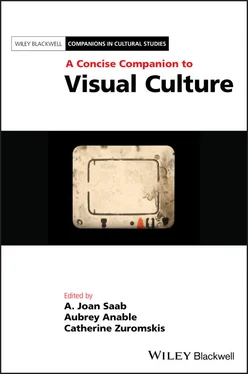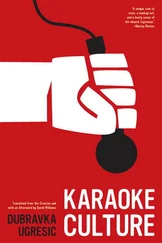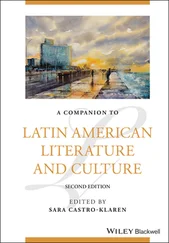1 ...8 9 10 12 13 14 ...36 Revising the book has never been simply a matter of updating examples or tracking the changes in visual culture on a global scale; it has been about accounting for the changes in theoretical frameworks and orientations with the urgency that situations in the world have demanded of us. We revised and updated our range of theorists and moved the book with the political times. Increasingly, aspects of the theory with which we began needed more critical contextualization; they had to be read as foundational, but also as problematic and limited in relation to contemporary visual culture, as we underwent shifts in the framing of matters of identity, race, class, nationality, sexuality, and ability in relation to visual practice and visuality. We increasingly reworked the canon that we had introduced in the beginning, even as we aimed to expand and revise it.
In the 2010s we also felt that the field itself was shifting toward important new emphases, toward a focus on visuality, countervisuality, visual activism, and decolonial frameworks, much of which Nicholas Mirzoeff (2011, 2016) has taken on in his own work in the field and we have incorporated into the book’s theoretical framework. De‐emphasizing representation as a form of analysis in the book was motivated in part by the recognition that we needed to emphasize fields of visuality, the built environment, and the increasingly constitutive aspects of the visual in fields like science and medicine.
The different editions of the book chart a particular history of the field that has become more institutionalized since we began this project: there are now doctoral programs focused on visual culture (at the University of California, Irvine, Brown University, and New York University); there is a field‐specific journal (the Journal of Visual Culture ); and there is a biannual conference with a professional association (the International Association for Visual Culture). In the same way, our own academic affiliations have migrated toward the field. Marita now teaches in the Department of Media, Culture, and Communication at New York University, which places a strong emphasis on visual culture through such scholars as Nicholas Mirzoeff, Allen Feldman, Erica Robles‐Anderson, and Kelli Moore, for example. Lisa is now on the faculty of the Visual Arts Department at the University of California San Diego, where she teaches with Rochester program founder Norman Bryson and with Grant Kester, who received his PhD from that program, with science, art, and film historian Alena Williams, with activist artist Ricardo Dominguez, and with pictures generation artist Amy Adler, among others. San Diego’s visual arts curriculum combines art and media practice, theory, history, and criticism, and the department offers one of the few art practice PhD concentrations in art history in the United States. In a certain sense, we have inadvertently contributed to an institutionalization of the field—which, as these trajectories can attest, was the least of our concerns when we first began writing a book together in the late 1990s. It is our hope that, in the current political climate of 2020—when we revise and update this contribution amid a global viral pandemic and a national uprising against epidemic police violence directed at black and brown people—our book may be useful to artists and scholars who are hoping to act and make changes in ways that engage and resist visuality in its relationship to meaning and power. We persisted with the book as toolkit for action and engagement, a role that we hope it will continue to serve.
1 Berger, John. 1972. Ways of Seeing. London: Penguin.
2 Gee, Gabriel. 2017. Art in the North of England, 1979–2008. London: Routledge.
3 Haraway, Donna. 2016. Staying with the Trouble: Making Kin in the Chthulucene. Durham, NC: Duke University Press.
4 Harris, Jonathan P. 2001. The New Art History: A Critical Introduction. New York: Routledge.
5 Jõekalda, Kristina. 2013. “What Has Become of the New Art History?” Journal of Art Historiography 9: 1–7.
6 Mirzoeff, Nicholas. 2011. The Right to Look. Durham, NC: Duke University Press.
7 Mirzoeff, Nicholas. 2016. How to See the World: An Introduction to Images, from Self‐Portraits to Selfies, Maps to Movies, and More. New York: Basic Books.
8 Sedgwick, Eve Kosofsky. 2002. Touching Feeling. Durham, NC: Duke University Press.
9 Sturken, Marita and Lisa Cartwright. 2018. Practices of Looking: An Introduction to Visual Culture, 3rd edn. New York: Oxford University Press.
Chapter 2 Horizontal Thinking and the Emergence of Visual Culture
Louis Kaplan
If one looks to the horizon, then one discerns a key element in the emergence of visual culture in the Anglo‐American context during the mid‐twentieth century. In helping to set the scene, I would like to offer some reflections on the importance and implications of the figure of horizontality and of thinking horizontally in a few critical texts foundational to visual cultural studies. In these texts, horizontality is championed and idealized as the level playing field or democratic ground for the constitution of visual cultural meaning, and often in direct opposition to what it is condemned as art history’s insistence on hierarchies and its elitist positioning. In some cases, we find that horizontality offers to viewers new perspectives for perceiving and apprehending the work and its significance. Moreover, horizontality becomes a way of marking visual culture’s proclivity toward interdisciplinary approaches and its affinity with the logic of the network. In light of this fascinating range of roles, I am interested in reviewing the political, ethical, and aesthetic force of horizontal thinking as a key rhetorical trope in the formation of visual culture as an emerging mode of criticism and as a new discursive field. It is my contention that, rather than appearing out of nowhere, horizontal thinking was articulated as a rupture within art historical thinking and directly against its valorization of fine art as a privileged object of study. This path‐breaking emphasis on horizontality is found in the texts of a few mavericks who moved away from art history either partially or completely. In Great Britain, horizontal thinking was framed in the mid‐1950s, in terms of “the long front of culture,” in the writings of the art critic and curator Lawrence Alloway (1926–1990) and in the context of the Independent Group, of which he was a founding member. About two decades later, it was the neo‐Marxist critic John Berger (1926–2017), with his passion for a radically democratic art practice, who would espouse and circulate many ideas that reflected horizontal thinking (even though he did not use the term per se ) in the initial program of his epoch‐shifting TV series and book Ways of Seeing (Berger 1972).
On the American side of the ledger, it was the art critic and historian Leo Steinberg (1920–2011) who broke away from the formalist mode of art criticism to engage the importance of horizontality in the late 1960s and early 1970s with the topsy‐turvy figure of the flatbed picture plane and in stark contrast to his arch‐enemy Clement Greenberg’s conception of flatness as a marker of medium specificity. This bold move also enabled the positing of a postmodernist paradigm shift, as Steinberg located this horizontal demand specifically in Robert Rauschenberg’s combine paintings and intermedia work of the 1950s. It appears to be no accident that Steinberg’s and Alloway’s horizontal readings engage with the emergence (and proto‐history) of pop in Great Britain and the United States, as the works of Jasper Johns, Robert Rauschenberg, Roy Lichtenstein, Richard Hamilton, and Eduardo Paolozzi among others provided early food for visual cultural thought and served as direct counterparts to the vertically informed positions of high or fine art defenders. Thus the emergence of a visual culture articulated on horizontal thinking was allied to the rise and embrace of Anglo‐American pop as a mass‐mediating and levelling phenomenon, before its legitimization (and institutionalization) as fine art.
Читать дальше












